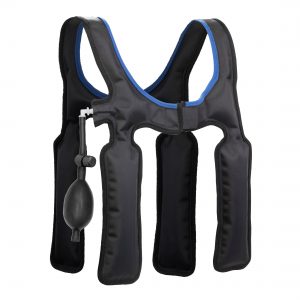1. The Importance of Ventilating Ballistic Vests Ventilating ballistic vests is essential for maintaining user comfort and ensuring the effectiveness of the protective gear. When ballistic vests lack proper ventilation, they trap heat and moisture, leading to discomfort and increased health risks for the wearer. Understanding the importance of venting ballistic vests guides the design of better protective wear. It also helps in selecting more comfortable gear.
a. Impact of Heat and Moisture Buildup Heat and moisture buildup in ballistic vests can quickly make wearers uncomfortable, reducing their focus and effectiveness in critical situations. Excessive sweating may lead to dehydration and heat exhaustion, especially in warmer climates or high-activity scenarios. Keeping cool under pressure is vital for maintaining composure in high-stress situations.
b. Comfort and Performance Relationship Comfort directly impacts performance. A ventilated vest ensures that the user remains cool and dry, allowing for prolonged wear without the distraction of heat or sweat. Officers and soldiers equipped with breathable vests can focus on their mission rather than the discomfort caused by heat buildup.
c. Common Ventilation Challenges Challenges arise in ensuring proper ventilation without compromising ballistic protection. Lightweight and breathable materials might lack the structural integrity needed for protection, while thicker materials could impede airflow. Balancing these elements requires innovative materials and design techniques.
d. Health Risks from Poor Ventilation Insufficient ventilation increases the risk of heat-related illnesses such as heat rash, heat exhaustion, and even heat stroke. Constant exposure to sweat can also lead to skin irritation, bacterial infections, and unpleasant odors that further decrease user comfort.
e. Field Feedback on Ventilation Issues Reports from field operators frequently highlight the discomfort caused by poor ventilation in ballistic vests. Such feedback underlines the necessity of continuous innovation in design to better accommodate the needs of users who often wear their vests for extended periods.
f. Overview of Ventilation Solutions Several solutions have emerged to improve ventilation in ballistic vests. From breathable fabrics and strategic padding placement to active cooling technologies, the aim is to provide effective protection while ensuring that users remain cool and comfortable during extended use. Choosing the right materials is essential for ventilation in ballistic vests. The materials need to provide airflow while ensuring the vest retains its protective qualities. Here’s a look at some of the best materials that help airing in ballistic vests.
a. Breathable Fabrics for Air Circulation Breathable fabrics allow air to circulate freely, aiding in sweat evaporation and reducing heat buildup. Fabrics like mesh and lightweight synthetics promote airflow while maintaining structural integrity. Their flexibility and breathability make them an excellent choice for improving comfort.
b. Moisture-Wicking Fabrics Moisture-wicking fabrics pull sweat away from the skin and spread it across the surface of the fabric, promoting faster evaporation. This technology keeps wearers dry and cool by ensuring sweat doesn’t saturate the vest and cause discomfort or chafing.
c. Antibacterial Layers to Prevent Odor Layers infused with antibacterial treatments help combat odor caused by sweat and bacterial buildup. These treatments prevent the growth of bacteria that thrive in warm, moist environments, ensuring the vest remains fresh even after extended wear.
d. Lightweight Mesh Linings for Airflow Mesh linings provide a secondary layer that helps air move between the vest and the wearer’s body. The small gaps between the fibers allow heat to dissipate, significantly reducing the chance of heat buildup and enhancing the breathability of the vest.
e. Innovative Cooling Fabrics and Technologies Some modern vests incorporate cooling fabrics and technologies that actively reduce temperature buildup. For instance, phase change materials (PCMs) absorb and release heat to maintain a constant temperature. These technologies can significantly improve comfort in hot climates.
f. Durability and Longevity Considerations While breathability and comfort are paramount, the durability of the materials is also crucial. Breathable fabrics must withstand rigorous use without tearing or losing their structure. Choosing high-quality materials ensures the vest provides long-lasting ventilation without compromising protection. 3. Design Features for Better Ventilation. The design of vests is crucial for proper ventilation. Design features can optimize airflow, manage heat, and enhance moisture control while still providing protection.
a. Ventilation Channels for air circulation are placed gaps that allow air to circulate through the vest. These channels are between the armor panels and the vest’s outer fabric. They create space for airflow to reduce heat buildup.
b. Strategic Padding Placement Padding, placed within the vest, enhances comfort and allows air to move freely. Vests place padding around high-heat areas, like the chest and back. This helps them manage sweat and heat. It keeps the wearer cool.
c. Perforated Panels and Spacers Perforated panels feature small holes that promote airflow without compromising structural integrity. Spacers create a gap between the vest and the body. They also improve airflow by stopping the vest from clinging to the skin.
d. Multi-Layered Ventilation Structures Multi-layered ventilation structures combine different materials to create a balanced airflow. For instance, a combination of breathable fabrics, mesh linings, and ventilation channels provides many layers of airflow and moisture management, enhancing the vest’s breathability.
e. External carriers hold the armor panels from the vest itself. They create extra space between the wearer’s body and the vest. This space makes more airflow. This design reduces heat buildup and promotes better ventilation, especially in tactical vests used by military personnel.
f. Modular designs allow wearers to customize their vest. They can change it based on the mission’s needs. This can include adding or removing ventilation features. This adaptability ensures that wearers can balance the need for ventilation with the specific protection required for their environment and task.
4. Advanced Cooling Technologies Advanced cooling technologies enhance the ability of ballistic vests to regulate body temperature, ensuring comfort during extended wear. These innovations incorporate active and passive cooling mechanisms to tackle heat buildup efficiently.
a. Phase Change Materials (PCMs) for Temperature Control PCMs are substances that absorb and release heat as they change between solid and liquid states. The materials are used in ballistic vests. They absorb heat from the body. This helps to regulate temperature and keep a cooler area around the wearer.
b. Battery-Powered Fan Integration Battery-powered fans integrated into the vest provide active cooling by circulating air across the wearer’s body. These fans can effectively reduce heat buildup in high-stress scenarios, ensuring continuous airflow in areas that often suffer from ventilation issues.
c. Cooling Gel Inserts Cooling gel inserts are removable pads filled with a cooling gel that absorbs and disperses heat. They can be placed within the vest to keep high-heat areas cool. These inserts can be frozen or refrigerated before use for added cooling capacity.
d. Air-Pumped Systems for Circulation: They circulate air within the vest using small, built-in pumps. The pumps move air through ventilation channels. These systems ensure continuous airflow, helping to prevent sweat buildup and heat retention, especially in hot and humid climates.
e. Wearable thermoelectric cooling uses devices that leverage temperature differences to provide active cooling. These devices can be embedded within the vest to actively cool the body, providing relief in extreme temperatures.
f. Some vests have hydration systems. They help regulate body temperature by providing easy access to fluids. Proper hydration is essential for maintaining a stable body temperature, and these systems ensure that wearers can stay hydrated without removing their vests. 5. Choosing the Right Ventilated Ballistic Vest Selecting the right ventilated ballistic vest involves considering factors that ensure both protection and comfort. Proper evaluation helps individuals choose a vest that meets their unique needs.
a. Assessing Mission and Environmental Needs Understand the mission and environmental conditions in which the vest will be used. For example, high-heat regions or intense physical activities require vests with advanced cooling and ventilation features.
b. Fitting and Sizing for Comfort and Ventilation Proper fitting is crucial for effective ventilation and protection. A well-fitted vest minimizes gaps between the body and the vest. This improves airflow and reduces discomfort. Always measure yourself to ensure the vest suits your body shape and size.
c. Balancing Protection and Ventilation Requirements test your specific protection needs against airing requirements. While maximizing ventilation is essential, the primary purpose of a ballistic vest is protection. Thus, a careful balance between protection level and comfort must be achieved.
d. Evaluating Modern Ventilation Technologies Keep up-to-date with the latest advancements in ventilation technology. New materials and cooling tech can make ballistic vests more comfortable. They provide better airflow and heat control.
e. Manufacturer Reputation and Quality Assurance Choose reputable manufacturers known for quality assurance and rigorous testing. A reliable manufacturer ensures that ventilation features do not compromise protection or durability, which is crucial for vests worn in critical situations.
f. User reviews and testing insights are valuable. They provide feedback on the vest’s real-world performance. Reviews from professionals who use the vest daily can give insight into its ventilation efficiency, comfort, and durability. Conclusion: Picking the right ventilated vest is key. It’s important for comfort, protection, and effectiveness in crises. Proper ventilation in ballistic vests impacts wearer performance and health, especially in high-stress environments. Understanding how heat and moisture buildup affect comfort and performance is important. It helps us see the need for smart ventilation.
The right materials, like breathable fabrics and moisture-wicking linings, can help. So can advanced design features, like ventilation channels and strategic padding. They make vests more comfortable without giving up protection. Advanced cooling technology, such as PCMs, battery-powered fans, and air-pumped systems, boosts the cooling effect. They bring relief in the toughest situations.
Choosing a ventilated ballistic vest is key. First, balance protection with ventilation. Then, ensure a proper fit and consider the mission’s needs. Keep an eye on ventilation technology advances. Also, trust well-known manufacturers. Finally, consider user feedback for the best choice.
Contact Bluhalo today. You can find the ideal ventilated ballistic vest. It will meet your protection and comfort needs!
FAQs Q: How does ventilation impro






